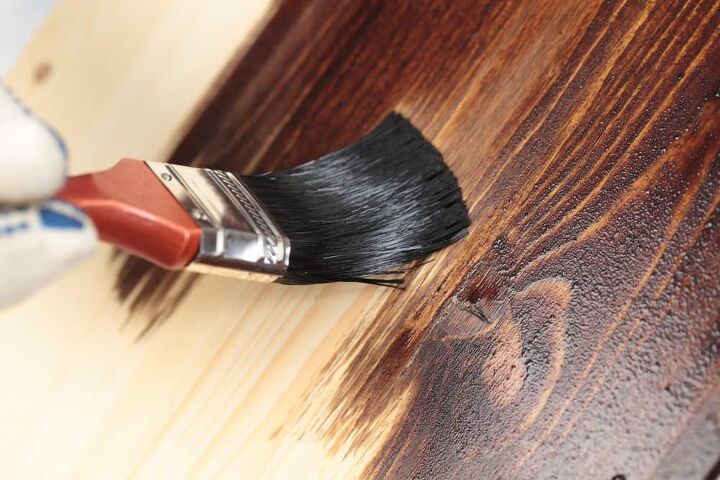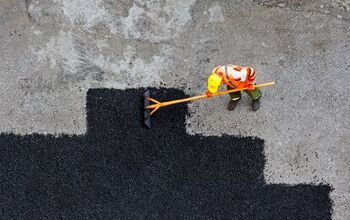How Long Does Wood Stain Take To Dry? (Find Out Now!)

There are few things that are as satisfying as seeing wood get a nice, even coat of stain. The right stain can make any furniture look elegant and picture-perfect. Of course, in order to get the kind of results you want to get, you need to make sure that the wood stain is dry before you finish things off. But, how long does it actually take for things to dry completely?
Standard oil-based stains will take one to four hours to dry to the touch. Polyurethane wood stains will take longer, with most drying completely within four. Outdoor wood stains and gel-based stains may take much longer, with most taking between 24 to 48 hours to cure. Water-based stains can take between one to two hours to be dry to the touch.
While knowing how long you have to wait before you can touch your wood is important, there’s a lot more to wood staining than just drying. This guide will help you understand what you need to know before you finish that first woodworking project.
How Long Before Your Wood Stain Feels Dry
As one would expect, different wood stains will have different drying times. The most reliable way to figure out how long your particular stain will take to feel dry to the touch is to check what your stain can says. If you can’t find any information there, you can always search for information about the stain online. With that said, you can often ballpark your drying time by the following standards:
- Fast-drying polyurethane can dry within two hours. Regular polyurethane stains may take four to eight, depending on the brand and the thickness of the coat applied.
- Oil-based stains can take one to two hours to feel dry. However, it can take four hours or longer before it’s entirely dry.
- Varathane stains can dry in as little as one hour, or as much as 12 hours. This brand-specific drying time is one of the most noteworthy in the biz.
- Water-based stains (like Minwax) are some of the fastest drying, and can be fully dried in an hour or two. It’s best to double-check your wood stain label to make sure it’s ready for finish.
- Gel-based stains can feel dry within eight hours, but can take far longer to actually be completely dry. Some people suggest that it’s best to wait at least 72 hours before applying finish.
Ballparking Wood Stain Drying Time By Usage
There’s another way to ballpark how long it’ll take for your wood stain to dry. Indoor wood stains are designed to dry faster, and tend to be in areas that are less humid, further speeding up the process. That’s why it usually takes six to 24 hours for interior stains to completely cure. Outdoor stains will need anywhere from 24 to 72 hours before you can apply a finish.
Can You Put Finish On Wood Stain Before It’s Completely Dry?
You might be tempted to add a second stain coat or a finishing coat on your wood before it completely dries. After all, it’s dry to the touch, so it should be okay, right? Well, not quite. While it may feel like it wouldn’t make that big a difference, you’d be wrong. If you apply another coat before the wood stain completely dries, you will have an uneven finish and may also end up with a project that feels sticky to the touch.
If you put a second coat (or a finish) on your wood before the first stain is dry, there’s a chance that the chemicals could intermingle. This could ruin the wood stain’s ability to permanently bond to your wood. This can lead to streaks, permanent stickiness, and more. If you have excess stain that can’t be absorbed, just remove the extra before you work on a finish.
Dry To The Touch vs. Totally Cured
When you’re perusing the net’s answers about drying times for wood stains, you might notice that there are different times cited. On some sites, you might see notes about whether a time means it’s dry to the touch versus completely cured. Here’s the big differences between each timing:
- When something is “dry to the touch” you can pick up the wood by hand without staining your hands. This means you can move it around, or that you won’t have to deal with your hands turning brown. (Of course, if you do get stains, you can still find a way to remove wood stain from your hands.)
- Being “dry to the touch” means that removing excess stain will be tricky but not a nightmare. Removing excess wood stain isn’t ever easy.
- When a stain is deemed to be completely cured, you are ready to add your finish. Adding it before it’s totally cured can run the risk of problems, so it’s always better to wait extra rather than risk it.
How Long Should You Wait For A Coat Of Wood Stain To Dry And Cure?
When you’re working on keeping your wood stain picture-perfect, it’s important to give your stains ample time to dry and cure. If you want to keep on the safe side, it’s best to let your wood stain cure for 24 to 72 hours. If you’re concerned about the curing time or notice that your stain dried slower than usual, stick to a 72-hour waiting period.
Why Does It Take Longer For Stains To Cure Outside Than It Does For Stains To Cure Indoors?
The noticeable difference between indoor and outdoor wood stain drying times deals with the environment that they’re meant to be used in. Most outdoor wood stains are meant to be more rugged than the ones indoors. They have to be able to withstand the elements, heavy rain, UV rays, and more. Indoor woodworking projects aren’t going to exposed to as much problematic stuff.
Since outdoor stains have to be thicker and more resilient, it can take a longer time to cure. Since indoor furniture is given more shielding away from the elements, thinner coats made with more drying elements can be doable.
What Impacts Wood Stain Drying Time?
It’s clear that there’s always going to be a range of times you can expect to see your wood stain cure, or at the very least, dry. You’re probably wondering what kind of factors can increase or decrease your stain drying times. Here’s the scoop on the most important factors that you need to be aware of:
- Humidity. It’s no surprise that humidity has a lot to do with the rate at which wood stain dries. If you want to get great results with any wood stain, it’s best to avoid putting on a coat during times of high humidity. This can make your wait time longer or even mess with the stain’s texture.
- Heat. Much like humidity, the temperature will have a major effect on your stain. When staining wood, try to keep your temperature between 40 to 70 degrees. Higher temperatures can cause bubbling and improper curing. If you notice the thermometer climbing while you’re working on a project, try to bring it indoors where it can stay cooler.
- Water Exposure. If you end up in a situation where water gets spilled on your stain, you may have a serious change in your stain’s drying time…not to mention the quality of results.
- Application Thickness. To a point, this is just common sense. If you lay on a thick layer of wood stain, it’s going to take a lot longer to cure. It’s worth noting that some types of wood stains are strongly advised against having thick layers, simply due to the makeup that they have.
- Wood Conditioning. Most wood stains will require a layer of wood conditioner prior to application. A good wood conditioner can help shorten drying times immensely.
What Are The Slowest-Drying Wood Stain Type?
The short answer to this question is that outdoor wood stains are the slowest-drying of the two main categories. However, there are subcategories here that go above and beyond the typical three-day curing time. These stains are excellent for high durability, but can take painstakingly long times to cure.
If you are willing to wait for a while, you can try to use a latex wood stain. Latex wood stains are currently the slowest-drying wood stain genre in the world. It can take up to two to three weeks for a latex wood stain to fully cure. It’s worth noting that most thin-build non-penetrative wood stains for outdoor use can also take up to 10 days to cure.
How Do You Remove Excess Wood Stain?
When applying wood stain, it’s best to stick to thinner coats. If you’ve waited for your stain to cure, only to find out that you’ve used too much, you can always remove it. The best way to get rid of excess wood stain is to dip an old toothbrush in solvent and gently spread the solvent on the stain.
Once some mineral spirit has been applied, use a terry towel to wipe up the extra stain. Leave it to dry, and you should have a wood surface that feels perfectly prepped for another coat.
Seems like a lot of problem? If you have wood that is currently loaded with too much stain to dry, some of it has to be removed. This is the only way to make sure that tacky stain that’s been cured will properly dry.
Related Questions
Why isn’t my wood stain drying?
A wood stain that doesn’t dry often has something to do with high humidity or water exposure that wrecked the stain’s ability to cure. If you stained your wood indoors, the most common culprit for a wood stain that won’t dry is a coat that’s too thick. Remove the excess and you should be able to see it dry.If you recently applied a finish or second coat on top of your original (still tacky) wood stain, you might be out of luck. This suggests that your wood stain’s chemistry may have been tampered with until it no longer will be able to bond with your wood.
Should you sand after staining your wood?
While sanding is an important part of woodworking, it’s not something you should do after you stain your wood. Your wood stain is remarkably delicate and likely only permeated the first layer or two of wood. If you sand your wood after you stain it, you will most likely remove the majority of the stain.The best way to treat your wood after you’ve stained it is to apply a finish on top. The finish is what will protect your stain and lock it into place. Otherwise, your stain will not be able to withstand the wear and tear of daily use.
Is wood stain waterproof?
It can be, but you have to make sure that you’re using a wood stain that’s designed with waterproofing in mind. Most outdoor/exterior wood stains are mixed with waterproofing chemicals that help prevent damage from rain, snow, and ice.If you want to make sure that your woodworking projects are resistant to the elements, it makes sense to get a wood stain on them.

Ossiana Tepfenhart is an expert writer, focusing on interior design and general home tips. Writing is her life, and it's what she does best. Her interests include art and real estate investments.
More by Ossiana Tepfenhart



























